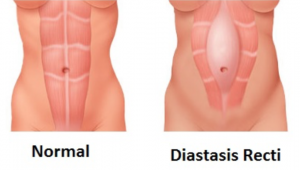Diastasis Recti is most commonly known for causing the “mommy belly” post pregnancy when the abdominal muscles are separated by the pressure of a growing baby and do not knit back together after birth. However, Men can get it, possibly from rapid weight gain and loss, from doing sit-ups or weightlifting the wrong way, or from other causes. Other than the aesthetic issues this condition causes it can also have major health impacts like back pain, constipation and in extreme cases hernia.
Most of the people who have this condition are new moms, it happens to about 2/3 of women during pregnancy and as they heal and begin a post natal exercise program much of the focus falls on the abdominal muscles. Some routine fitness moves, including crunches, sit-ups, pushups, press-ups, and front planks, can actually make abdominal separation worse. So can swimming, some yoga poses (like downward dog), and doing anything on your hands and knees. Some trainers may suggest those exercises for women with abdominal separation, not knowing what could happen. Before starting a workout regimen post baby, it is a good idea to do a self test to see if the gap in your abdominals is more than 2.7 centimeters. If it is, there are some specific programs and exercises to help correct it.
There are a lot of online resources that address Diastasis Recti, articles, YouTube videos, online workout memberships and programs like The Mutu System or the the Tupler Technique. One way to get started is with Core Compressions to restore firm, flat abdominal muscles. This is a deep, subtle movement – yet powerfully effective. For best results, place your hands on your abs throughout the set and perform a Kegel with each core compression. Start with 5 minutes a day. After one week, work up to 10 minutes a day (either 10 minutes all at once or 5 minutes twice a day). In as little as 6 weeks you will see visibly firmer, flatter abs and a smaller waistline.
Diastasis Recti is a real disorder, not just a mommy belly left over from pregnancy. There are real dangers to exacerbating the problem by exercising the muscles in the wrong way. If you think you may have diastasis recti try a home test or possibly ask your doctor, in some cases physical therapy is necessary to repair the damage. Abdominal separation resolves when either your muscles have pulled back together to less than two finger widths, or when you can feel that your midline has become strong and elastic, at about six to nine months postpartum. At this point, you will no longer feel a hole in your abdomen. Once your connective tissue has regained its former density and elasticity, you are no longer at risk for hernia or other associated problems.


